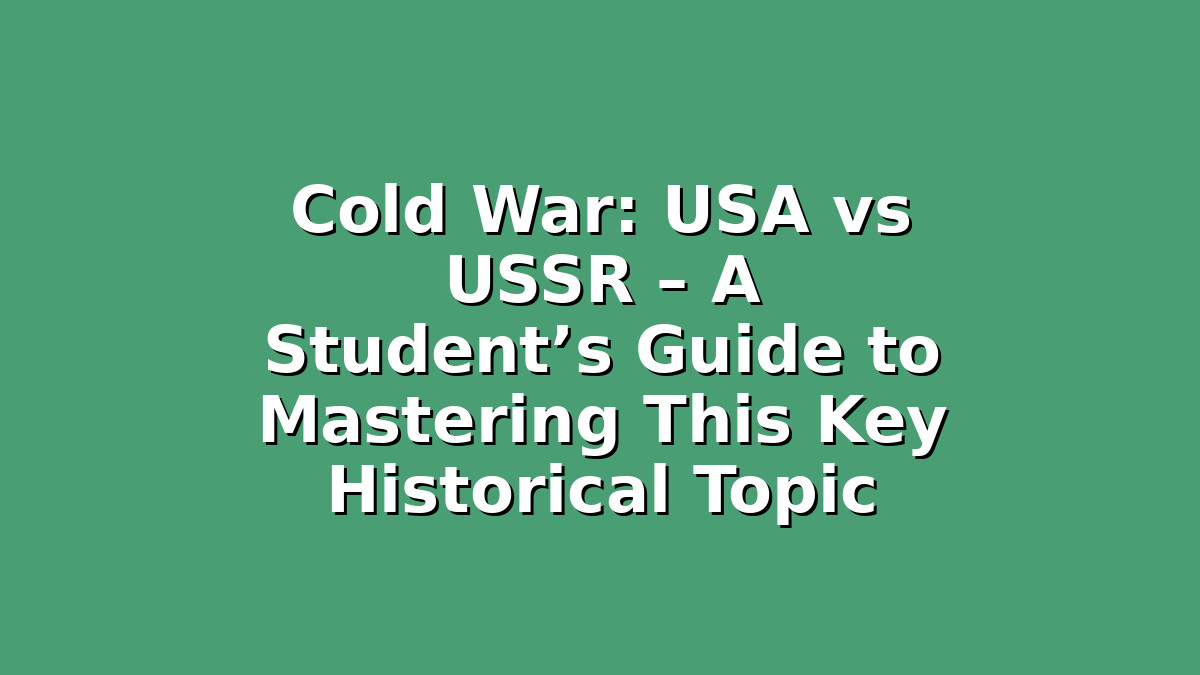The Cold War between the United States and the Soviet Union is one of the most significant events of the 20th century. Understanding this complex period is crucial for students preparing for history exams or those who want to deepen their knowledge of global affairs. This guide will break down the Cold War in an easy-to-understand way while providing practical study tips to help you remember key facts, analyze causes and effects, and write strong exam answers.
Introduction: Why the Cold War Matters for Students
The Cold War lasted from roughly 1947 to 1991 and shaped much of the modern world’s political landscape. It was a period marked by ideological conflict, arms races, and proxy wars—but never direct military confrontation between the USA and USSR. For students, the Cold War is often a challenging topic because it involves understanding political ideologies, global alliances, and complex events that unfolded over decades.
However, with the right approach, studying the Cold War can be manageable and even interesting. This article will cover three main areas: understanding the background and causes, examining key events and strategies, and mastering exam techniques with effective study tips. By the end, you’ll feel more confident tackling this topic in your exams.
—
Section 1: Understanding the Background and Causes of the Cold War
Before diving into specific Cold War events, it’s important to grasp why the conflict started in the first place.
Key Points to Know:
– Ideological Differences: The USA promoted capitalism and democracy, while the USSR pushed for communism and a state-controlled economy.
– Post-WWII Power Vacuum: After WWII, both superpowers emerged stronger but suspicious of each other’s intentions.
– Distrust and Fear: The nuclear arms race and espionage heightened tensions.
– Division of Europe: The Iron Curtain split Eastern (Soviet-influenced) and Western Europe (USA-influenced).
Study Tips:
– Create a Timeline: Start by making a simple timeline of events from the end of WWII to the start of the Cold War. This helps put causes in chronological order and shows how one event led to another.
– Use Mind Maps: Draw a mind map linking key causes like ideology, WWII aftermath, and nuclear weapons. Visual aids help connect ideas and improve memory.
– Summarize in Your Own Words: After reading about the causes, write a short summary without looking at your notes. This reinforces understanding and highlights areas for review.
—
Section 2: Key Events and Strategies of the Cold War
The Cold War featured many important incidents and tactics. Knowing these helps you explain how the USA and USSR competed without direct war.
Important Events to Focus On:
– The Berlin Blockade and Airlift (1948–1949): The USSR blocked access to West Berlin; the USA responded by airlifting supplies.
– The Korean War (1950–1953): A proxy war where the USA supported South Korea and the USSR backed North Korea.
– The Cuban Missile Crisis (1962): A tense standoff over Soviet missiles in Cuba that brought the world close to nuclear war.
– The Space Race: Competition to achieve space exploration milestones symbolizing technological and ideological superiority.
– Detente and Arms Control Treaties: Periods of eased tensions and agreements like SALT I to limit nuclear weapons.
Study Tips:
– Use Flashcards: Create flashcards with the name of the event on one side and key facts, dates, and significance on the other. Regular review strengthens recall.
– Relate Events to Causes: When studying each event, link it back to the broader Cold War causes and strategies. For example, the Cuban Missile Crisis was partly about nuclear deterrence and fear of surprise attacks.
– Practice Explaining Events Aloud: Teaching a friend or recording yourself explaining events helps clarify your understanding and builds confidence.
—
Section 3: Exam Techniques and Writing Effective Answers
Knowing facts is important, but being able to write clear and well-structured answers is essential for exam success.
Tips for Tackling Cold War Questions:
– Read the Question Carefully: Identify if it asks for causes, effects, comparisons, or significance.
– Plan Your Answer: Spend a few minutes outlining your points. For example, if the question asks about the causes of the Cold War, list your main causes before writing.
– Use Evidence: Support your points with specific examples like the Berlin Airlift or the Cuban Missile Crisis.
– Explain and Analyze: Don’t just state facts—explain why they mattered. For example, “The Berlin Airlift showed the USA’s commitment to containing communism and preventing Soviet expansion.”
– Practice Past Papers: Doing practice questions under timed conditions helps improve your ability to organize thoughts quickly.
Study Tips:
– Write Sample Answers: After studying events, write practice paragraphs or essays. Ask teachers or peers for feedback.
– Use the PEEL Method: Point, Evidence, Explanation, Link—this technique keeps your paragraphs clear and focused.
– Stay Updated on Marking Schemes: If your exam board provides marking criteria or sample answers, review these to understand what examiners expect.
—
Conclusion: Stay Positive and Consistent in Your Cold War Studies
The Cold War between the USA and USSR may seem complicated at first, but breaking it down into causes, key events, and exam techniques makes it more manageable. Remember to use timelines, mind maps, and flashcards to reinforce your learning. Practice explaining events out loud and writing structured answers to build confidence.
Keep a positive mindset—learning history is not just about memorizing dates but understanding how events shaped the world. With steady effort and smart study strategies, you’ll be well-prepared to tackle any Cold War question in your exams. Keep going, and don’t hesitate to ask your teachers for help or use additional resources like documentaries and reputable websites to deepen your understanding.
Good luck with your studies!
—

Responses